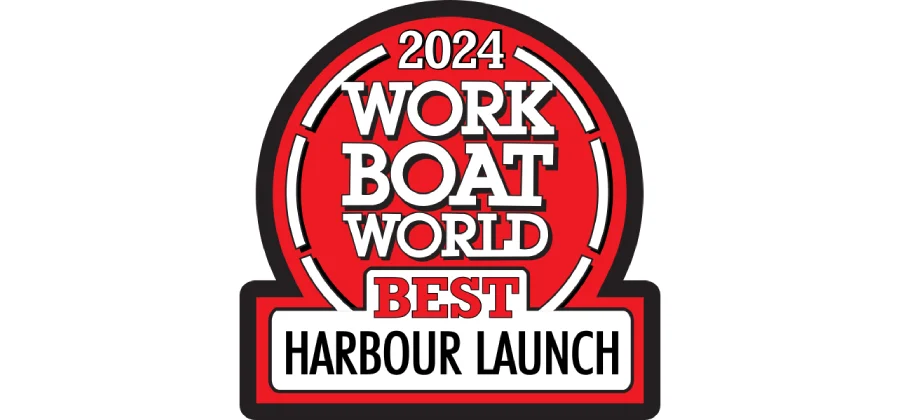AWARDS 2024 | Best Harbour Launch – Giles S – Global Marine Design & BtB Marine
An economical, safe, ”nippy” and versatile aluminium launch for dredger support in Australia’s fast growing Port of Brisbane, the outboard-powered Giles S can quickly deliver supplies and personnel throughout the port’s extensive area.
It’s a simple, light boat with full, rigid foam floatation, that can be readily craned aboard its mother dredgers if required. It has been constructed so that its petrol (gasoline) fuelled motors can be upgraded to diesels if required.
“The boat features Global Marine Design’s (GMD) unique ‘cathedral’ hull, which ensures excellent dynamic stability and seakeeping,” Jayden Mair, Managing Director at GMD, told Baird Maritime. “Feedback from Port of Brisbane is that the vessel ‘punches above its weight’, which is perfect considering the limited dimensions we had to work with.
“It is also the first boat in its series to be built with level flotation buoyancy fitted, which was another requirement of the operator.”
"It has the ability to take on heavy weather while maintaining crew comfort with its super fine entry while also being super stable at rest with its tri-hull design," added Chris Hough, General Manager at BtB Marine.
Through multiple discussions with the port and the builder, we arrived at a sensible arrangement that will serve the port for years to come.
Mair explained that, as with many small vessels, allocating space for crew, passengers, fuel, deck cargo and stores while maintaining suitable trim and stability compliance proved challenging with Giles S, particularly when the boat’s wide bulwarks are foam-filled for level flotation.
“Through multiple discussions with the port and the builder, we arrived at a sensible arrangement that will serve the port for years to come.
"This being GMD’s first design project with Port of Brisbane and the builder, we’ve taken the time to learn how these organisations operate as well as requirement and detail preferences that can be applied to future projects."
As regards lesson taught by the boat's construction, Hough remarked that BtB Marine, "learned a lot about putting the hulls together," and that the company has been fortunate to have been able to apply those lessons in other similar vessels it has since been selected to construct.
In Mair’s view, the advent of 3D naval architecture software has resulted in a growing number of shipyards being forced to depend on inadequate design drawing packages.
“The software can make it very easy to produce large ‘pretty’ drawing packages that are lacking in dimensions, annotation and assembly instructions, which give the drawings limited use on the workshop floor.
"We’ve been making a concerted effort to use 3D structure models to supplement a detailed 2D drawing set, which has had great results with our clients.”
"The biggest impact we see day to day on the construction of smaller work vessels in Australia is that the NSCV is still not as clear as it can be, thus leaving room for different interpretations from profesionals state to state," added Hough, who then went into further detail about BtB Marine's activities in 2024.
As for the harbour craft industry, we view it as a suitable entry point for those wishing to ease into decarbonisation.
"Our year consisted of moving fully into our new marine precict in Hervey Bay. It has been the culmination of three years of planning and is now the home of BtB Marine. In the future, we hope to have other like-minded marine businesses join us here and make it one of regional Australia's most capable centres of marine excellence."
Mair said there is a growing desire for vessel autonomy and electric/hybrid propulsion, and that Australia seems to be lagging behind other countries in terms of regulation, promotion, and updating of the requisite technologies.
“As for the harbour craft industry, we view it as a suitable entry point for those wishing to ease into decarbonisation,” Mair told Baird Maritime. “These vessels tend to have lower endurance requirements and better availability for charging points.
"Singapore’s Maritime and Port Authority is a perfect example of this, and we can only hope that Australia will follow suit with similar government initiatives to help reduce marine industry emissions."
"I think that one of our main focuses is preparing for the uptake of uncrewed 3D printed vessels," said Hough. "We have had a good history so far with automation and intend to move forward in both of these areas while continually improving on our core business."
As for the Australian workboat industry, Hough believes it will decentralise and that the federal and state governments will have an, "appetite to some extent to give smaller companies an opportunity, at least in the smaller boat segment of the market."
For a list of the 2024 "Best Of" award winners, please click here.


